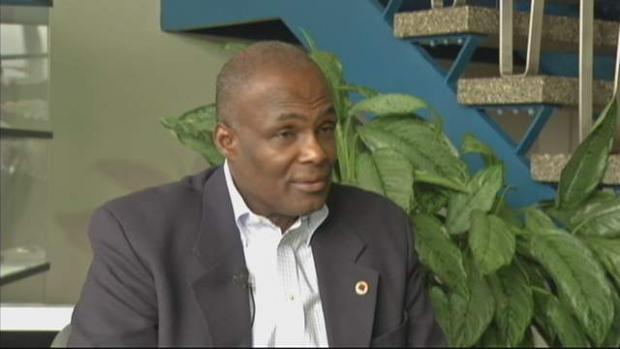The Public Record: Bernie or Bust?
On Tuesday night, Bernie Tolbert made it official: He’s running this fall for Erie County Sheriff, the office that many thought Tolbert should have pursued several years ago, when he retired to his hometown of Buffalo after an impressive career in public law enforcement (FBI agent in charge of the Buffalo office) and private security (for the NBA, Coca-Cola, HSBC).
Though courted as a candidate for sheriff, Tolbert instead ran for mayor of Buffalo against incumbent Byron Brown in 2013. That seemed at the time a fool’s errand—Brown looked to be a lock that year to win his third term, and it turns out he was, if only as a result of lethargy: The turnout for the Democratic primary in the city that year was abysmal, just 23,018 votes cast. Brown won 15,487 of those, Tolbert just 7,110, with 421 “blank, void, and scattering.” That was—sorry, Bernie—a poor showing, both in votes won (31 percent) and turnout. In 2009, when Mickey Kearns challenged Brown, 41,671 voters came to the polls, and Kearns’s loss was 35.7 percent to 63.1 percent. Still not great, but Kearns mustered twice the votes in the city that Tolbert did.
And votes in the city, not relative failure in challenging Brown, is what matters in this fall’s election for sheriff. To win countywide, Tolbert must turn out Democratic voters in the November general election. Not in the September primaries, when city Democrats are accustomed to voting, but in November, when those city voters often stay at home. And he must also turn out the pockets of Democrats who abide elsewhere in Erie County—in the towns of Evans and Hamburg, in the village of East Aurora, in the towns of Cheektowaga, Kenmore, and Tonawanda.
How many votes does it take to win the sheriff’s office? A ton: In 2009, 163,094 people cast ballots in the race, in which the current sheriff, Republican Tim Howard, beat Democrat John Glascott by a hair. In 2013, county elections were twisted to a fare-thee-well by the inexplicable machinations of Steve Pigeon and his Western New York Progressive Caucus, the electioneering of which has led to criminal indictments. Still, the turnout was about 20,000 voters heavier, and Howard won only because there was a third candidate on the ballot that November: Bert Dunn, a deputy sheriff from a well-to-do family who was the Democratic Party headquarter’s pick for the office, lost in the primary to the Pigeon-backed Dick Dobson, but kept a November ballot slot on the “Law & Order” party line, which Howard owned in 2009. Dunn garnered 29,158 votes on that line in November, despite hardly campaigning past the primary. Howard, in that general election, won by fewer than 7,000 votes over than Dobson, who also ran out of campaign and money after the primary. Dunn made the difference. Howard, despite the advantages of incumbency, is vulnerable.
So how does Tolbert win? First, he must see 20,000 voters or more in the city in November—again, not in September, for the primary, which will turn out twice that many. And he must turn out those 20,000 city voters on his own in November, because there will be no other city-relevant elections at that point: The mayoral race will be won or lost in September, the county clerk’s race will be by then (with apologies to Mickey Kearns and Steve Cichon) a yawn, and the county comptroller’s race is dull, too. To win, Tolbert must find issues that will inpsire voters to come to the polls. Heavy turnout always favors Democrats, so the local Republican leadership will seek to keep November’s general election quiet.
Dobson found nearly 20,000 city votes in 2013, despite (or perhaps because of) a rancorous Democratic Party. He found 35,000 more votes outside the city. Tolbert will need to find more still, as Glascott did in 2009: Glascott got just 15,144 votes in the city on the Democratic line, but 70,531 total. Where did the balance come from? Tonawanda, West Seneca, Cheektowaga, the Democratic enclaves of Amherst, and the surprisingly stalwart Democratic enclave of Hamburg—those places alone accounted for about 40,000 of Glascott’s votes in 2009 and almost all of Dobson’s in 2013.
Law enforcement offices ought to be nonpartisan: The county sheriff is a manager. His job is to enforce—not to interpret, overrule, or create—the law. Tim Howard seems to think otherwise, and that brings us to our final chapter: What do you do? What does a smart, African-American, well-qualified Democrat running for countywide office do against a white-as-my-grandfather, suburban-based Republican who countenanced Confederate flags and swastikas at a rally he attended wearing a uniform we all pay for? What does Tolbert do against someone who says he doesn’t just oppose but will refuse to enforce the state’s gun laws? What do you say to a public official who went so far as to misquote Malcolm X at a rally that featured those Confederate flags?
There is a deep, abiding progressivism among the region’s Republicans. It’s a recessive trait but manifests in the narrow margins by which the Republican sheriff has been elected the last two cycles. There is also the Tea Party faction who helped to elect Donald Trump president, and who don’t seem to care that Howard is one of the worst managers of a municipal jail system in the country. I wonder if Tolbert can sell himself to those conservative but amenable pockets—he is, after all, a law-and-order guy, a middle-of-the-road Democrat with an impeccable curriculum vitae—and whether he can muster the money and the energy to turn out the city vote. If he can’t, is it because he’s black? Who shows up in November? Who is actually invested in our local politics? And why?

